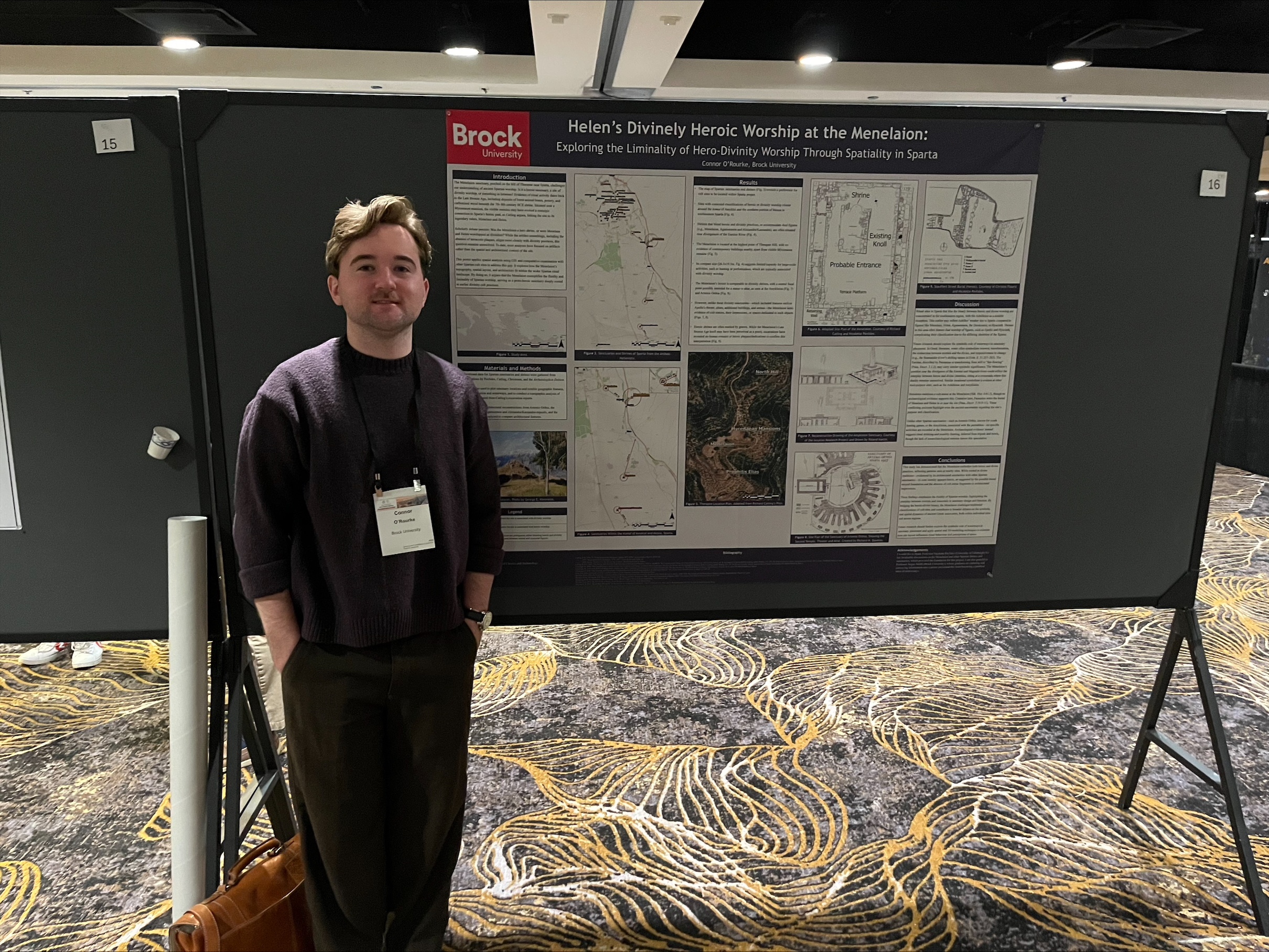January 21, 2025
At the 2025 AIA Annual Meeting (Philadelphia), we saw a variety of posters featuring work from around the world. Annual Meeting participants were treated to an incredible array of diverse research presented in a visual format.
Three Poster Awards are given out during the Poster Award Sessions: the Best Poster Award, First Runner-Up, and the Student Poster Award.
We asked the winner of this year’s Best Student Poster Award a few questions about himself and his project:
Best Poster Award Recipient: Connor O’Rourke
“Helen’s Divinely Heroic Worship at the Menelaion”
The Menelaion sanctuary, situated atop Therapne Hill near Sparta, challenges conventional classifications of ancient Greek cult sites by blending heroic and divinity worship elements. While prior studies have focused primarily on artifacts and written accounts, this poster adopts a spatial and architectural perspective, employing GIS-based analysis to examine the site’s topography, layout, and position within the broader Spartan ritual landscape. By comparing the Menelaion with other sanctuaries, such as Artemis Orthia and the Amyklaion, this research highlights the site’s distinct features, including its compact size, elevated location, and lack of graves or cult statue evidence. The findings suggest that the Menelaion functioned as a transitional sanctuary, occupying a liminal space in Spartan worship that blurred the boundaries between heroic and divinity cult practices. Its placement near the Eurotas and Magoula Rivers and other geographic features points to a symbolic connection with themes of renewal, transformation, and duality in ritual contexts. These spatial insights reflect the complexity of Spartan religious traditions, where Menelaus and Helen were simultaneously revered as heroes, divinities, or neither, depending on the interpretative lens. By situating the Menelaion within its physical and ritual context, this research provides new insights into the dynamic interplay between space, architecture, and ritual behaviour in Spartan sanctuaries. Future work could expand this analysis by incorporating 3D modelling to reconstruct the site’s architectural features and by further exploring the role of geographic symbolism in sanctuary placement, particularly in relation to waterways and other natural landmarks within and around Sparta.
Connor O’Rourke, Brock University

How long have you been a member of the AIA? How many Annual Meetings have you attended (in-person or virtually)?
CO: I have been a member of the AIA since 2023. This is the first Annual Meeting I have attended, and it was absolutely amazing. There was a talk, booth and poster for everyone’s interest, and it was a great experience to meet researchers whose work I have been a big fan of.
How did you first come to this project/topic?
CO: I discovered the topic of the Menelaion during my final year of undergraduate studies while taking a course on Helen taught by Dr. Adam Rappold. The course explored her various depictions in myth, literature, archaeology, and across different eras of human history. Researching the Menelaion has proven to be both fascinating and frustrating. As scholars, we often strive to follow clearly defined paths or establish universal laws and categories. However, the Menelaion defies such classifications, fitting neither neatly into the category of a “hero shrine” nor a “divinity shrine.” This ambiguity is what makes it so compelling to study and why I chose it for my poster.
What is one cool fact or interesting result from this project that didn’t make it onto the final poster?
CO: One aspect I did not delve into on my poster but found fascinating about the Menelaion is that the debate over how to classify it isn’t just a modern scholarly discussion—it was also a point of confusion and debate among ancient authors. For instance, Alcman and Isocrates each offer their perspectives, but my personal favourites are Herodotus and Pausanias. Among other observations, Herodotus mentions a cult statue of Helen, which suggests elements of divinity worship. Centuries later, Pausanias describes the site as the burial place of Helen and Menelaus, aligning more closely with heroic worship practices. I don’t necessarily believe either interpretation is incorrect. Instead, I think these accounts reflect the evolving nature of Spartan worship practices, shaped by the authors’ respective time periods. This fluidity highlights how beliefs changed and developed over time, making it difficult—and perhaps futile—to try to label the Menelaion definitively as either a “hero shrine” or a “divinity shrine.”
What is your advice to students/new authors who are preparing posters for upcoming conferences?
CO: My best advice for preparing a poster is to start planning early, have a clear understanding of what needs to be included to effectively showcase your ideas, and design a format that is easy to follow while logically conveying your message. Aim to keep the word count relatively low and incorporate visuals such as images, tables, and graphs to communicate your ideas quickly and effectively to passersby who may be interested. Strive for a well-balanced layout by breaking up sections of text with visuals to maintain engagement. One approach I personally recommend is creating a central focal point on your poster that highlights important information. For example, I placed the results section at the center of my poster. I thought this not only broke up the surrounding visuals but also provided a concise and salient breakdown of my findings in just a few sentences, making it easy for viewers to grasp the takeaways at a glance.
Notifications